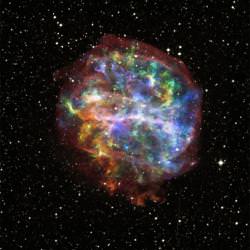This absolutely beautiful object has a big of a bizarre name: G292.0+1.8. But don’t let that astronomical jargon throw you, you’re looking at a supernova remnant, captured by NASA’s Chandra X-Ray Observatory and ground-based observatories. It’s considered a textbook example of what remains after a massive star blows itself apart as a supernova. But it’s got a few surprises too.
Near the core of G292.0+1.8 is a pulsar wind nebula, revealed by the X-rays pouring out of it. This is the magnetized bubble of high energy particles that surround the rapidly spinning pulsar at the heart of the nebula. The pulsar is all that remains of the star before it detonated as a supernova.
Here’s one of the surprises. Instead of being right at the centre of the nebula, the pulsar is located slightly below and to the left. It possible that the supernova explosion was lopsided, and the recoil sent the pulsar shooting off to its current location. That would be a fine explanation, except the kick direction and pulsar spin direction aren’t aligned like you would expect.
Another interesting feature is that long white line running across the centre of the remnant called the equatorial belt. Imagine this is ring of material that unraveled from the star as it was coming apart. Once again, the orientation of this belt suggests that the parent star had the same spin axis before and after it exploded.
Astronomers find it puzzling that the remnant is missing thin filaments of high energy X-ray emission. These are thought to be a source of cosmic ray acceleration, and have been seen in many other well known supernova remnants. It’s possible that G292.0+1.8 is just too old now, and that stage only happens when the remnant is young.
Original Source: Chandra News Release

